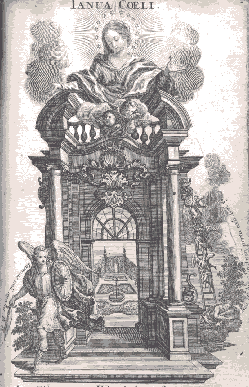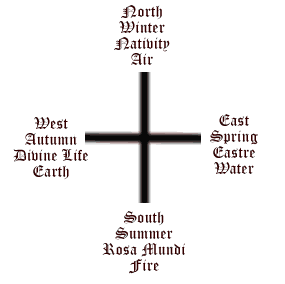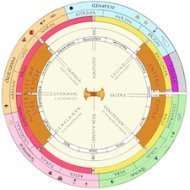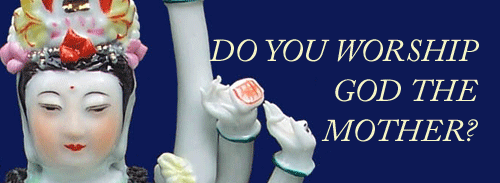Janua Coeli : Heaven's Gates
A study in the traditional symbolism of the Summer and Winter Solstices

"Janua Coeli: Heaven's Gates" is a study of the two cardinal points of the year from the traditional perspective, in which time and space are not rigidly distinguished: for the Winter and Summer Solstices are not only points in time, but also the "Northern" and "Southern" entrances to and exits from the world of matter.
In discussions of the Wheel of the Year, it has been explained that the different phases of the yearly cycle create different conditions within the heart of maid.
We may explain this a little further by saying that the different phases of the year are in fact different "places" in both psychic and symbolic terms. Many traditional symbolic designs are indeed 'maps' of the year, seen as a geometric "territory".
The simplest and most fundamental of these is the cross itself. Of course the cross has many "other" meanings: but since the fourfold cross and the four seasons of the year are precisely analogous (the fifth season of Moura corresponding to the centre of the cross), all the meanings of the cross are transferable to the year and vice versa; indeed we may say that it is impossible fully to understand the one without the other.

The solstices make up the vertical axis, the direct ray of divine light that descends from Our Mother God (at once the "Central" and the "uppermost" point of being), while the equinoxes make up the horizontal axis – a particular plane of manifest existence (usually our own) upon which the perfect Forms or Archetypes transmitted by the Divine Ray combine with the "matter" of that plane to take on substantial forms. It is for this reason that winter and summer correspond to the "subtle" elements of air and fire and spring and autumn to the "gross" elements of earth and water.
The two solstices, at the highest and lowest points of the year, are called janua coeli or "heaven's gates"; for they are the two points of entry and exit from the world-cavern in which we exist (that is why both the Nativity and Rosa Mundi periods are noted for the manifestation of subtle entitles on the world).
An old Herthelan rhyme goes as follows:
The city hath full seven gates
A maid may travel through;
But when thou speakst of Heaven's gates
Know thou there are but two.The Southernmost of Heaven's gates
Stands where red roses grow;
The Northernmost of Heaven's gates
Doth open in the snow.The Southernmost of Heaven's gates
Leads far beyond the sea;
The Northernmost of Heaven's gates
Leads high above the tree.
"Beyond the sea" refers to the Daughter's paradise of Avala which is said to lie far in the Western Ocean, while "above the tree" refers to the transcendence of the material world above the central World Tree (the highest earthly part of the World Axis, growing atop the Sacred Mountain).
The winter and summer solstices, as Heaven's gates, are known respectively as the Gate of Dea and the Gate of Maid, and this corresponds exactly to the solstitial mysteries, for the Nativity mystery is precisely concerned with the descent of Dea into the world-cavern, while the Rosa Mundi mystery is concerned with the ascent of maid "like a lark" directly upward into perfect union with Dea.
The complementarity between the two solstices corresponds to the third and final declamation of the quintessential déanist statement of faith, the Drispeal: "God became maid that maid might come to God".
From another perspective, however, each of Heaven's gates is an exit through which maid may pass out of the world-cavern. In this case, the Gate of Dea leads to the "Northern Way" by which maid passes into her perfection and does not return to the world of manifestation whether on this earth or otherwise; the Gate of Maid leads to the "Southern Way" in which maid reaps the reward of her merits in a heavenly state, but, being yet imperfect, must return again to the samsaric world of change and becoming, death and decay.
The paths to which the each of Heaven's gates leads correspond to the two halves of the year: the "ascendent" half in which the sun's strength waxes towards the fullness of midsummer, and the "descendent" half in which her strength wanes toward midwinter. We may see then that the path which begins from the Gate of Dea leads through the sacrifice of Eastre (in spring) in which the soul must give herself to death – that is, the destruction of her ego; all that she calls her self as opposed to her true Self, which is none other than the Spirit Herself; for as a Filianic Scripture says:
"the Spirit is One, and I am the Spirit, and thou art the Spirit also, In the Innermost Temple of thy heart."
This sacrifice truly is a death: the death of the personality, the ego, the self – of everything that retains the illusion of being other than Dea; and it is only through this death that the soul may pass through the heart of the sun into the immortality that lies beyond – into perfect union with Dea.
This, then, is the Northern Way, passing through the sacrifice of Eastre into the consummate union of Rosa Mundi. The Southern Way, which is the lesser, begins from Rosa Mundi. This may at first seem confusing, but it is to be understood that once one has come out of the world-cavern through one of Heaven's gates, we are no longer speaking of the earthly passage, but of its heavenly equivalent. Therefore the ascendent path leads from the earthly nativity to the heavenly Rosa Mundi, while the descendent path leads from the earthly Rosa Mundi to the heavenly Nativity.
The descendent, or Southern Path, is for those who are not ready to accept the death of the self; who lead a good and devout life and yet remain within the world of change and becoming. This path leads not to the absolute "Heaven" of perfect union, symbolised by the rose garden, but to the relative heaven from which the soul must return to her journey – the apple orchard, the Western Paradise of Avala.
Janua Coeli : Heaven's Gates continues after break
The Southern Path thus leads to Avala at the Autumn Equinox (which corresponds to the Western direction), just as the Northern path leads to the Rose Garden at Rosa Mundi; but unlike the Northern Path, it does not end at its "heaven" but passes on to the Northern Gate of Nativity, which, from the Heavenly point of view (and, as we have seen, it is the Heavenly Nativity that is here in question), is the place of descent or coming-to-earth. It is also, of course (from the earthly standpoint – and it is to the earthly Nativity that the descent leads) the starting-point of the Northern Path. Thus the Southern Path is also analogous to the Lesser Mysteries, which purify maid and lead her to the very portal of the Greater Mysteries.
We may see, then, that the two paths, the path of return and the path of non-return, are inverse images of one another. The ascendent path leads through an analogy of Our Lady’s Death to Heaven; the descendent path leads through heaven to an analogy of our Lady’s birth.
One further apparent paradox remains. It may at first sight appear contradictory that the ascendent path of the sun's waxing should lead from the highest (or Northern) point of the cross to the lowest (or Southern), while the descendent path of the sun's decline leads from the lowest point to the highest. But this is due to the law of inverse analogy. As with reflections in a pool, whatever is in Heaven is reflected upon earth in inversion; thus, from the earthly point of view, the Winter Solstice corresponds to the northern point of the compass, but from the Solar (or Heavenly) perspective, the Winter Solstice is precisely the moment at which the sun reaches the southernmost point of her annual journey (this, of course, is within the ambit of a geocentric symbolism).
It is by precisely the same inversion that what on earth is the Gate of Ascent is in Heaven the point of descent, while what on earth is the lower Gate is from the heavenly perspective the sun-door itself.
From the earthly standpoint, however, the Gate of Dea is the Gate par excellence; the "uttermost Gate" (English "utter" is cognate with Sanskrit uttara which means not only "highest", "superior", "last", but also "northern"). Thus January, the Tellurian name for the month in which all but the first day of Nativity falls, derives from Latin janua a gate or door.
The chimney, which is literally a "hole in the roof" is, in microcosm, an image of the access by which Dea breaks into the world. It is for this reason that the French cheminée (chimney) is related to chemin (way).
Caminus, a Latin word of Greek origin, means hearth or furnace (and originally also chimney) and is related to Spanish and Italian camino meaning again "way". It is by no mere coincidence that the Star Fairy enters the house via the chimney, especially since, being the Rayin (princess) of the sylphs or air-spirits, she is the direct representative of Vaya, the Breath or Wind which is the Spirit of Dea (Spirit and [re]spiration being two forms of the same word); nor is the practice of sending written petitions up the chimney (borne by up-currents created by the confluence of air and fire) so frivolous in its origins as it has become in modern practice.
The Mystery of Nativity and the Mystery of the Hearth are closely related, and their relation is actualised by one very ancient and profound Herthelan custom: the relighting of the hearth-fire on the Day of Herthe was always done with the remnants of the Ashen Faggot or Log from the previous Nativity (this itself being lighted from the Altar Flame). In this act is realised the reflection of the Summer Mysteries of fire and the sun in the events of the Winter Solstice.
For traditional science teaches that all fire is a yerthing (coming-to-earth) of the Sun; and since we, through our fall, have cut ourselves off from the supernal Sun, Who is Our Mother God, it is only through Her coming-to-earth that the hearth-fires and the Altar Flame are lighted.
Thus, by this tradition, the complex interrelation of both of Heaven's gates is enacted.
While we have explained the doctrine of Heaven's gates in Déanic terms – which are naturally of the most importance to devotees of Our Mother God, the concept of the two solstices as Heaven's gates is found widely throughout many traditional cultures – sometimes in cases where "influence" or "borrowing" seem out of the question.
While profane scholarship may find this difficult to explain, there is really no difficulty in understanding the matter. The facts of Traditional thought are perceived by pure Intellect just as the facts of material existence are perceived by the physical senses. If two widely separated cultures tell us that the sky is blue and the grass green, we do not have to ask which influenced the other.
Similarly – as with so many traditional "motifs" that may be properly designated as "Archetypes" – the reason different cultures see the solstices as Heaven's gates is simply because the solstices are Heaven's gates.
See also:
The Festival of Nativity: The Winter Solstice – Northern Gate
The Festival of Rosa Mundi: Summer Solstice – Southern Gate
The Christmas Tree: History, Meaning and Symbolism
Please support the Chapel of Our Mother God
Send Questions or Comments on Heaven's Gates
Chapel of Our Mother God Homepage
All written material at the Chapel of Our Mother God is copyright. Should you wish to reproduce any portion please contact us for permission.
Facebook or Twitter
Wheel of the Year
Articles on the Months, Seasons and Festivals of the year in feminine religion General The High Feast of EastreThe End/Beginning of the Cycle
- All about Eastre: The Last Festival and the First
- An Easter Hymn
- The Marianna Maria Chant
- The True Meaning of the Eastre Egg
- Chelanya: The Feast of Regeneration
- Cuivanya: The Feast of Divine Life
- Tamala: The Feast of the Dead
- All about Nativity
- The Birth of God the Daughter
- Winter Solstice
- The True Meaning of Christmas
- Amaterasu Omikami and the Spiritual Meaning of Midwinter
- The "Christmas Tree"
- The real Christmas Tree Angel
- "Hail to the Princess" carol
- The Day of Our Sovereign Lady
- Maia's Day
- The Day of Werde
- Early Winter Festivals
- The Conception of God the Daughter
- The Day of Sai Herthe
- The Epiphany of Our Lady
See the Wheel of the Year Click below to see the full image of the Sacred Year, or go here for a basic introduction.

Click to enlarge
Once you have enlarged the image you can use the Ctrl + and - keys (Command + and - on a Mac) to resize the Wheel to your exact requirements.Gospel of Our Mother God
The Gospel of Our Mother God is a collection of inspirational texts, prayers and daily inspiration for the Mother-Faith devotee or household.
The Feminine Universe
The Other Philosophy
Everything you have ever heard comes out of the patriarchal world-view. Its materialism, its religion, even its feminism. Here is the other way of seeing the world; the natural way: the way that everyone saw things before patriarchy and will again when patriarchy is long forgotten.


